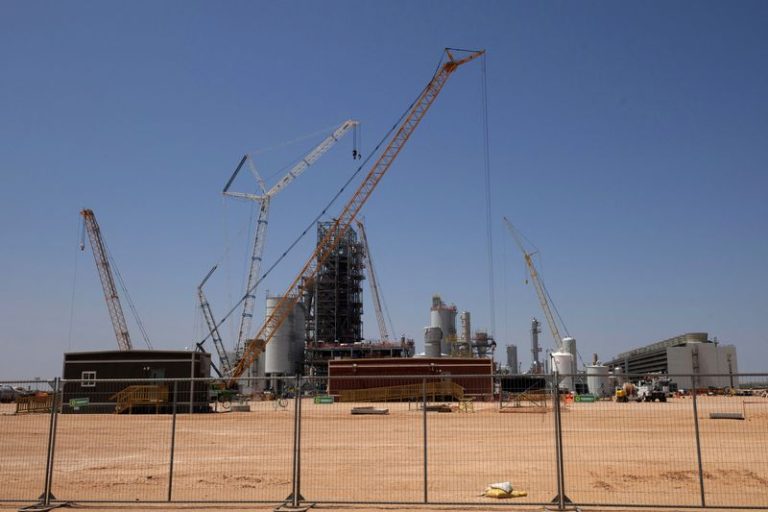By Valerie Volcovici and Leah Douglas
(Reuters) – Texas has seen surging interest from companies hoping to bury carbon dioxide in its oilfields, putting the state at the vanguard of a government-subsidized program to fight climate change.
But pumping CO2 into the ground could exacerbate earthquakes and well blowouts already happening in the Permian Basin as Texas struggles to manage wastewater disposal, potentially undermining public support.
“Without legitimate oversight of underground injection in Texas, we expect more geyser-like well blowouts, sinkholes, leaks from plugged and unplugged wells, and injection-induced earthquakes,” said Virginia Palacios, executive director of Commission Shift, a Texas watchdog group pushing for tougher oversight of the oil and gas industry.
Such consequences have rarely happened as a result of CO2 injection over the decades the technology has been deployed. The unprecedented vast volume of carbon now proposed for burial, however, worries activists and researchers.
Carbon sequestration is vital to U.S. government goals to reduce emissions that cause global warming. The Biden administration’s 2022 Inflation Reduction Act, landmark climate-change legislation, includes billions of dollars worth of subsidies for CCS projects.
While President-elect Donald Trump has vowed to gut the IRA, energy experts say CCS subsidies will likely survive due to bipartisan support.
Trump’s transition team did not provide comment.
Several companies, including Occidental Petroleum (NYSE:OXY), plan to take advantage of IRA subsidies. The projects are concentrated in Texas, where CCS proponents argue underground geology is ideal for storing liquid and gaseous waste.
PERMIT APPLICATIONS JUMP
Over the last 12 months, the number of applications filed with the Environmental Protection Agency for carbon injection permits in Texas has jumped by 63% to 43, according to the agency, making it a national leader.
But Texas is dogged by problems linked to disposal of drilling wastewater underground. The Texas Railroad Commission (RRC) regulator has grappled with leaks and blowouts from orphan wells, as well as earthquakes, triggered by higher pressure underground from water injection.
Reuters spoke with a dozen Texas landowners and researchers who said proposed CO2 projects need more oversight than the state can offer to avert environmental and safety risks.
The RRC is seeking authority from the EPA to oversee its own permitting program for carbon sequestration to speed up approvals. The EPA, which is also reviewing Texas’ handling of wastewater permitting following the blowouts, said the request was being considered.
The RRC said in a statement it is capable of effectively regulating CO2 injection wells, adding it has hired more staff.
Trump’s victory increases the chances Texas will get this authority, experts say. North Dakota was the first state to receive oversight authority during Trump’s first term and its governor, Doug Burgum, is Trump’s pick for interior secretary, which includes responsibility for drilling permits on federal land.
Burgum did not respond to requests for comment.
REASON FOR CONCERN
One of the biggest Texas projects is the Stratos direct air capture joint venture in Ector County between Occidental and asset manager BlackRock (NYSE:BLK). It is expected to inject 8.5 million metric tons of CO2 annually starting next year.
The county has numerous abandoned wells at risk of erupting if underground pressure rises and CO2 eats away at cement plugs, said oil and gas attorney Sarah Stogner, who represents landowners that have had blowouts.
There have been 19,700 wells drilled in the county since 1993, according to data from state agencies. Nineteen are orphan wells, with no company legally responsible for ensuring they remain plugged, including three close to the Stratos site.
Raymond (NS:RYMD) Straub, a hydrogeologist who owns a Texas groundwater services firm, testified at an October EPA hearing that he was concerned Occidental did not devote enough attention to the unplugged or badly plugged orphan wells in the project area.
Occidental spokesperson William Fitzgerald said the company had done extensive site surveys to ensure it would be safe.
“There is more than 3,000 feet of confining rock layers above the sequestration zone to securely contain the CO2,” he said.
A pilot project by agribusiness ADM in Illinois, the first of its kind meant to demonstrate the technical feasibility of commercial carbon injection, has suffered leaks and other setbacks, underscoring worries.
ADM spokesperson Jackie Anderson said the leaks have presented no risk to surface or groundwater or to public health, and that the company is confident in CCS technology.
Dominic DiGiulio, an independent energy analyst and former EPA official who has studied CCS, said, however, that CO2 can corrode the cement casings of plugged wells.
“These abandoned wells will in fact leak,” he said.
A 2023 paper by Chinese researchers, published in Earth-Science Reviews, said CO2 injection could also boost the risk of earthquakes.
The researchers did not respond to requests for comment.
Large leaks could acidify groundwater, and suffocate people and animals if it displaces oxygen above ground, according to nonprofit Pipeline Safety Trust.
“This is supposed to be permanent storage,” said Carolyn Raffensperger, executive director of the Science and Environmental Health Network. “If it can’t even contain it for 10 years, why do we think it can contain it forever?” she added, referring to ADM’s project.

